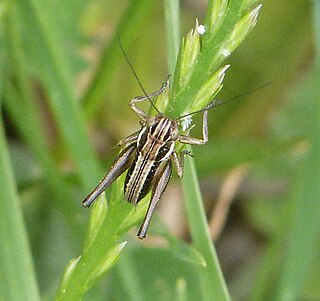
Bandwings, or band-winged grasshoppers, are the subfamily Oedipodinae of grasshoppers classified under the family Acrididae. They have a worldwide distribution and were originally elevated to full family status as the Oedipodidae. Many species primarily inhabit xeric weedy fields, and some are considered to be important locusts:

The grasshopper subfamily Acridinae, sometimes called silent slant-faced grasshoppers, belong of the large family Acrididae in the Orthoptera: Caelifera.

The Tettigoniinae are a subfamily of bush crickets or katydids, which contains hundreds of species in about twelve tribes.

Austroicetes is a genus of grasshoppers in the subfamily Oedipodinae and family Acrididae. Members of the genus typically feed on grass and herbs.

Toxoderidae is a family of praying mantises.

The Phaneropterinae, the sickle-bearing bush crickets or leaf katydids, are a subfamily of insects within the family Tettigoniidae. Nearly 2,060 species in 85 genera throughout the world are known. They are also known as false katydids or round-headed katydids.

Gomphocerinae, sometimes called "slant-faced grasshoppers", are a subfamily of grasshoppers found on every continent but Antarctica and Australia.

Anacridium is a genus of "tree locusts" or "bird grasshoppers" belonging to the subfamily Cyrtacanthacridinae.

Valanga is a genus of "bird grasshoppers" in the subfamily Cyrtacanthacridinae. Species are found from the Indian subcontinent through southeast Asia and the Korean peninsula to Australia and the Pacific islands.

Patanga is a genus of grasshoppers in the subfamily Cyrtacanthacridinae. Species are distributed throughout Asia: from India, China, Japan, Indochina and western Malesia. The genus was named by Boris Uvarov in 1923, with the type species the economically significant Bombay locust, which has also been placed in genus Nomadacris.

The Hemiacridinae are a subfamily of Acrididae in the Orthoptera: Caelifera. Species can be found in Africa and Asia.

The Pyrgomorphinae are a subfamily of grasshoppers in the family Pyrgomorphidae. Species are found in, predominantly in the warmer regions of: Central and South America, southern Europe, Africa, Asia, Australia and Pacific Islands. The type genus is Pyrgomorpha and names dates from "Pyrgomorphiden" by Brunner von Wattenwyl, 1874. The first use of Pyrgomorphinae was by Krauss in 1890.

Eucoptacra is a genus of grasshoppers in the family Acrididae and subfamily Coptacrinae. Species can be found in: Africa, India, Indo-China, peninsular Malaysia and Borneo.

The Phlaeobini are a tribe of grasshoppers in the subfamily Acridinae. The recorded distribution of genera includes: Africa, the Middle East and Asia.

Leva is a genus of grasshoppers in the subfamily Gomphocerinae with species found in Africa and Asia.
Pusana is a genus of grasshoppers in the subfamily Oedipodinae with species found in the Indian subcontinent.

Acorypha is a genus of grasshoppers belonging to the family Acrididae.

Heteracris is a genus of short-horned grasshoppers in the family Acrididae. There are more than 60 described species in Heteracris, found in Africa, southern Europe, and manland Asia through to India.

Pterolepis is a genus of bush crickets in the subfamily Tettigoniinae and tribe Platycleidini erected by Jules Pierre Rambur in 1838. The known distribution is from North Africa and the Iberian peninsula.

Brachycrotaphus is a genus of grasshoppers in the subfamily Gomphocerinae, erected by Hermann August Krauss in 1877. Species have been recorded from Africa, southern Europe and India.


















